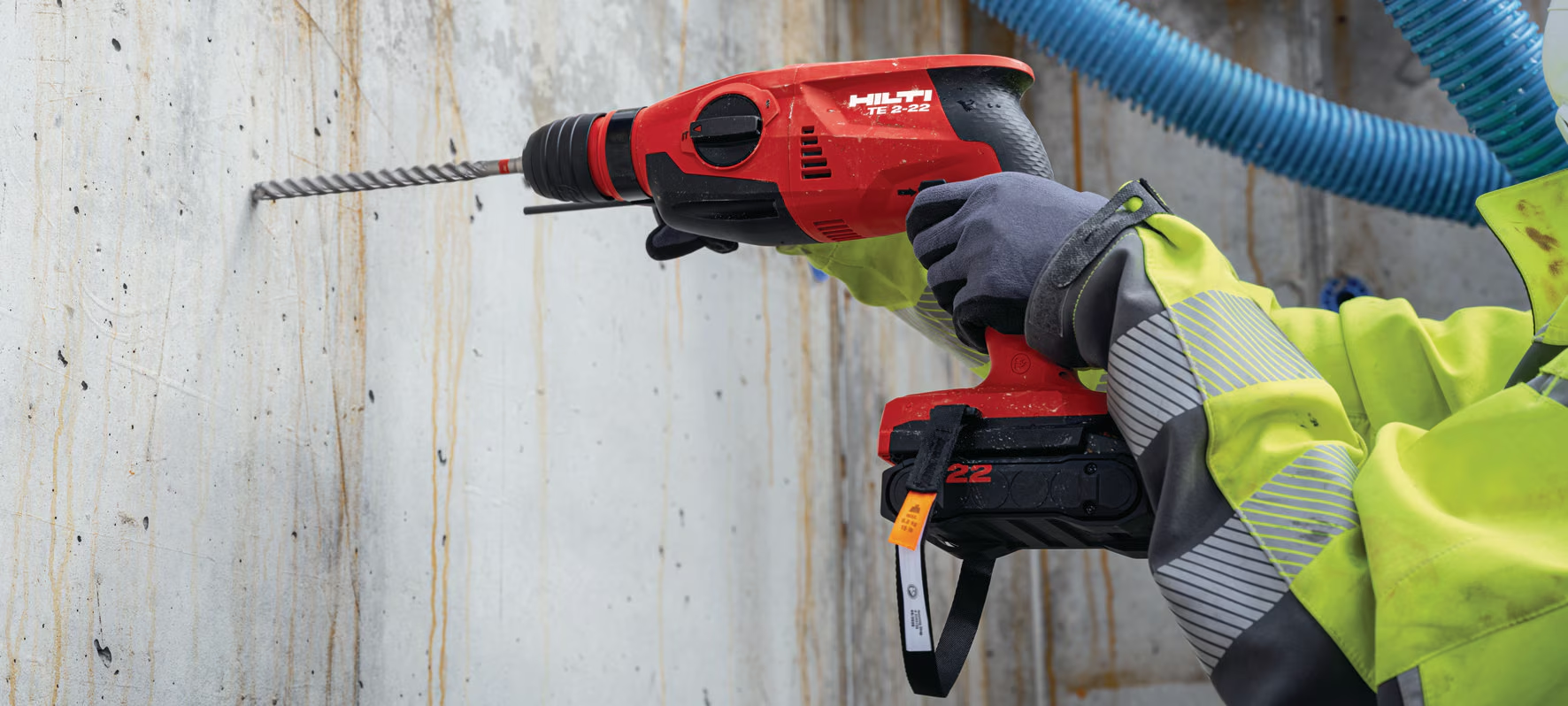Drilling into concrete can be a daunting task for any DIYer or professional. While concrete is strong and durable, it can also be difficult to penetrate without the right tools. The two main power tools used for concrete drilling are rotary hammers, hammer drills, and jack hammers. Both utilize percussion or hammering action to drive drill bits into concrete, but work in slightly different ways.
Rotary hammers combine rotation with hammering for maximum drilling power. They are designed specifically for concrete drilling and chiseling applications. Hammer drills provide a hammering action while spinning the drill bit. They can drill into concrete, but are more versatile general purpose drills suitable for drilling into wood, metal and masonry as well.
Choosing the right concrete drilling tool depends on factors like hole diameter, project scope and budget. Proper drill bits, safety precautions and setup are also critical for successful concrete drilling. This guide will provide an overview of concrete drilling tools, tips for selecting the right rotary hammer or hammer drill, and instructions for drilling safely and efficiently into concrete.
Table of Contents
What is Concrete?
Concrete is a composite material composed of fine and coarse aggregate bonded together with a fluid cement that hardens over time. The most common type of concrete is Portland cement concrete.
The key ingredients in concrete are:
- Cement – Usually Portland cement, this is a fine grey powder made by grinding limestone and clay minerals. When mixed with water, cement undergoes a chemical reaction called hydration that binds the other concrete ingredients together as it hardens.
- Aggregates – Sand, gravel, crushed stone, or other coarse materials added to provide bulk and strength to concrete. Aggregates make up 60-75% of concrete’s total volume.
- Water – Water triggers the chemical reaction that causes cement to harden in a process called hydration. Only enough water should be added to fully hydrate the cement. Too much water will result in segregation and weak concrete.
- Admixtures – Other substances added to modify the properties of concrete like its workability, curing rate, strength, or color. Common admixtures include air-entrainers, water reducers, set accelerators, and plasticizers.
The exact proportions of cement, aggregates, water, and admixtures determines the properties and performance of the final concrete product. Professional concrete mix design aims to optimize the amounts of each ingredient for the application at hand.
Why Drill into Concrete?
There are several reasons you may need to drill into concrete:
Install Fixtures
Concrete is strong and durable, making it ideal for installing permanent fixtures. You’ll need to drill holes to mount things like light fixtures, cabinets, railings, and more. Mark the location and drill a hole slightly larger than the anchor or screw to solidly mount the fixture.
Run Wiring
For lighting, outlets, and appliances, you’ll need to run wires through concrete walls and floors. Drill holes through the concrete to create a path to feed the wiring from the power source to the outlet. Use conduit to protect the wires.
Plumbing
Just like wiring, you need to drill passageways through concrete for water supply lines, drain pipes, and vents. Core drilling can make large, clean holes for running multiple pipes. Or you can drill smaller holes for individual plumbing needs.
Drilling into concrete allows you to permanently install fixtures, lighting, outlets, and plumbing even in solid concrete structures. The right drilling tools make puncturing concrete quick and easy.
Craftsman Jack Hammers: Power and Precision for Heavy-Duty Tasks
When it comes to tackling tough demolition and construction tasks, the right tool can make all the difference. Craftsman jack hammers are designed to deliver power, precision, and durability, making them a top choice for professionals and DIY enthusiasts alike. Here’s an in-depth look at Craftsman jack hammers and how they can be a game-changer for your heavy-duty projects.
Exceptional Power and Performance
Craftsman jack hammers are engineered to provide maximum impact and efficiency. Their high-performance motors and robust construction ensure that they can handle even the most demanding demolition tasks with ease. Whether you’re breaking through concrete, asphalt, or other tough materials, Craftsman jack hammers deliver the power you need.
Ergonomic Design for Comfort and Control
Long hours on the job require tools that are comfortable and easy to handle. Craftsman jack hammers feature ergonomic designs that reduce user fatigue and increase control. With cushioned grips and adjustable handles, you can maintain a firm, comfortable hold, allowing for precise operation even during extended use.
Versatility for Various Applications
From construction sites to home improvement projects, Craftsman jack hammers are versatile tools suitable for a range of applications:
- Concrete Removal: Perfect for breaking up old concrete slabs, driveways, and patios.
- Asphalt Cutting: Efficiently cuts through asphalt for roadwork or driveway repairs.
- Tile and Brick Removal: Ideal for remodeling projects that require the removal of old tile or brickwork.
- Foundation Work: Assists in excavating and preparing foundations for new construction.
Durable Construction for Longevity
Craftsman jack hammers tools are known for their durability, and their jack hammers are no exception. Built with high-quality materials and rigorous manufacturing standards, these tools are designed to withstand the rigors of heavy use. This longevity ensures that your investment in a Craftsman jack hammer pays off over many years of reliable service.
Safety Features for Secure Operation
Safety is paramount when working with powerful tools. Craftsman jack hammers are equipped with features that enhance user safety:
- Anti-Vibration Technology: Reduces the amount of vibration transferred to the user, minimizing the risk of strain injuries.
- Automatic Shutoff: Prevents the tool from overheating and extends its lifespan.
- Safety Guards: Protect the user from debris and accidental contact with the working surface.
Easy Maintenance and Service
Keeping your tools in peak condition is essential for optimal performance. Craftsman jack hammers are designed with easy maintenance in mind. Accessible components and clear maintenance guidelines ensure that you can keep your tool running smoothly with minimal effort. Additionally, Craftsman’s extensive service network means that professional help is always available if needed.
Rotary Hammers
Rotary hammers are powerful tools designed specifically for drilling into concrete and masonry. They utilize a combination of hammering and rotation to efficiently penetrate hard materials.
How Rotary Hammers Work
The key difference between rotary hammers and standard hammer drills is the inclusion of a pneumatic hammering mechanism. Compressed air is used to rapidly hammer a piston in the drill head, creating a powerful percussive force. This hammering action is combined with the rotating chuck, allowing the drill bit to pulverize and chip away at concrete. The hammering supplements and enhances the rotation, making drilling much faster.
Rotary hammers use SDS or Spline drive drill bits. These bits have a special shaft that fits into the chuck. When hammering occurs, the bit can slide back and forth while still rotating. This allows for both hammering and twisting simultaneously.
Uses for Rotary Hammers
Rotary hammers are designed for heavy duty concrete drilling. Their main uses include:
- Drilling holes for concrete anchors and fasteners
- Core drilling for plumbing and electrical runs
- Drilling into foundations, walls, floors, and ceilings
- Demolition work – chipping away tile, brick, and stone
- Driving ground rods into tough soil
Larger rotary hammers can also be used with chisels and other attachments for chipping, scraping, and demolishing.
Benefits of Rotary Hammers
Compared to standard hammer drills, rotary hammers provide:
- Faster drilling into concrete and masonry
- Ability to drill larger diameter holes
- More powerful hammering mechanism
- Less strain on the user due to reduced vibration
- Longer life span even with heavy use
Rotary hammers are the best choice when deep drilling or large holes are needed in concrete or similar materials. Their optimized percussion system makes tough jobs much easier.
Hammer Drills
Hammer drills are a popular power tool used for drilling into concrete and other masonry. They provide a hammering action in addition to the rotating drilling motion, making them ideal for hard materials.
How They Work
The hammering mechanism in a hammer drill is activated by a cam. As the chuck spins, the cam causes a hammer inside the drill to rapidly move back and forth. This hammering motion is applied to the bit, pulverizing the concrete as the bit rotates. The hammering action combined with the drill rotation results in quick progress through concrete and masonry.
Uses
Hammer drills are designed for concrete drilling tasks like:
- Drilling holes in concrete walls to hang shelves or anchors
- Drilling into brick or concrete for installing electrical boxes or running conduit
- Drilling holes in concrete floors, walls, or ceilings to mount fixtures like lights or fans
- Drilling into tile, stone, or masonry for anchors and fasteners
They can drill holes up to 1/2″ in diameter in concrete. Hammer drills aren’t designed for heavy duty drilling of large holes.
Benefits
The key benefits of hammer drills include:
- Faster drilling in concrete and masonry than regular drills
- Ability to drill holes not possible with a regular drill
- More compact size than rotary hammers for tight spaces
- Less expensive than rotary hammers
- Easier to control than more powerful rotary hammers
- Versatile for both hammer drilling and regular drilling in wood/metal
Hammer drills provide an affordable and effective option for most small DIY concrete drilling tasks. Their hammer mechanism makes drilling concrete faster and easier without the higher cost of a rotary hammer.
Choosing Between Rotary Hammer and Hammer Drill
When deciding between a rotary hammer and hammer drill for drilling into concrete, there are a few key factors to consider:
Power
Rotary hammers are more powerful than hammer drills. They generate significantly more impact power and torque, allowing them to drill larger diameter holes and handle tough concrete more easily. Rotary hammers use a piston mechanism that generates around 5,000-6,000 BPM (blows per minute) while hammer drills use a ratcheting mechanism that generates around 10,000-45,000 BPM. The piston design gives rotary hammers more force. If you need to drill holes over 3/4″ in diameter or work with reinforced concrete, a rotary hammer is the better choice.
Speed
Hammer drills operate at much higher speeds – around 1,200-1,500 RPM – compared to rotary hammers at around 250-600 RPM. The higher speed makes hammer drills better for drilling smaller diameter holes as well as for drilling into brick or other soft masonry where impact power isn’t as important. For larger holes or concrete, a rotary hammer’s slower speed provides more control and precision.
Hammering Mechanism
As mentioned above, rotary hammers use a pneumatic piston mechanism that generates lower BPM but higher force, while hammer drills use a ratcheting mechanism with higher BPM and lower force. The piston on a rotary hammer provides constant impacting while the ratcheting mechanism on a hammer drill engages only while pressing forward on the bit. So rotary hammers perform better for heavy duty concrete drilling.
In summary, for serious concrete drilling with larger diameter bits, a rotary hammer is the best choice. But for lighter duty tasks or drilling into softer materials, a hammer drill can often get the job done at a lower price point. Consider how much power you’ll need and what types of holes you’ll be drilling before deciding which tool is right for the job.
Drill Bits for Concrete
When drilling into concrete, using the right drill bit is crucial for smooth, fast drilling and clean holes. There are a few main types of drill bits to choose from:
Masonry Drill Bits
Masonry drill bits are made of high-speed steel and designed for drilling into brick, concrete block, mortar and stone. They have a carbide tip to cut through the abrasive materials without excessive wear. Masonry bits come in a range of sizes. They can be used with rotary hammers and hammer drills.
Masonry bits are a good economical choice for most general concrete drilling work. However, they may wear faster or struggle with denser concrete compared to advanced bits.
Carbide-Tipped Bits
Carbide-tipped drill bits have small carbide inserts at the tip to bore through concrete with ease. The carbide provides hardness for cutting, while the steel body allows for flexibility. These bits are more durable than standard masonry bits.
Carbide-tipped bits work well for most concrete drilling applications. They have a longer lifespan than standard masonry bits and can drill smoother holes. They are a step above basic masonry bits but less expensive than diamond bits.
Diamond-Tipped Bits
Diamond-tipped drill bits contain industrial-grade diamonds at the tip and are the strongest concrete drill bits. The diamonds easily grind through any type of concrete. Diamond bits can drill the smoothest, cleanest holes through dense, reinforced concrete.
Diamond-tipped concrete bits are ideal for heavy-duty projects with abrasive materials like rebar. They have a long service life but are more expensive. Save diamond bits for hardened concrete or when high-precision holes are needed.
Setting up and Drilling
When drilling into concrete, proper setup and technique are important for success. Here are some tips:
Marking the Hole Location
- Use a marker or pencil to mark the exact spot where you want to drill. This will help keep the drill bit stable and prevent it from wandering.
- For accuracy, you can make a center punch mark at the location to help guide the drill.
Starting the Hole
- Place the drill bit at your marked location, holding it as vertical as possible.
- Start slowly, letting the hammering action of the rotary hammer penetrate the surface. Apply light pressure at first.
- Once the drill bit has made an indentation in the concrete, you can apply more downward force.
Applying Pressure
- Apply steady, even pressure in a straight downward direction as you drill. Don’t push too hard or drill too fast.
- Let the tool do the work, allowing it to hammer its way into the concrete. Avoid putting excessive body weight into it.
- Advance the bit slowly and smoothly into the concrete. Ease up if you encounter rebar or very dense areas.
- Take breaks periodically to avoid overheating the bit. Spraying water will help cool the bit.
- Reduce pressure as the bit nears the back of the hole to avoid breakthrough damage.
Safety Tips
When drilling into concrete, safety should always be your top priority. Here are some key tips to keep in mind:
Wear Safety Gear
- Wear eye protection like safety glasses or goggles to prevent concrete dust and debris from getting in your eyes. Small concrete particles can scratch your cornea.
- Wear a dust mask or respirator to avoid inhaling concrete dust, which contains crystalline silica. Inhaling this dust can lead to lung disease.
- Wear earplugs or earmuffs to protect your hearing from the loud noise generated by hammer drills and rotary hammers. The noise can exceed 100 decibels.
- Wear thick work gloves to protect your hands from abrasions and burns. The vibration from hammer drills can damage nerves and blood vessels in bare hands.
Control Dust
- Use a vacuum attachment on your drill to contain dust. Many hammer drills and rotary hammers allow you to attach a vacuum.
- Keep a wet rag nearby to wipe down dust. Avoid using compressed air to blow away dust.
- Drill holes at an angle rather than straight on to prevent dust from blowing directly at your face.
Check for Hidden Wires
- Use a wire detector to scan for hidden electrical wires, conduits or plumbing before drilling. Concrete can conceal dangerous live wires.
- Check blueprints of the building if available.
- Drill a small pilot hole first, then check it with a wire detector before drilling the full size hole.
Concrete Drilling Tools Guide
Concrete is one of the most durable and versatile construction materials, but drilling holes in it requires using the proper tools. Having the right concrete drill and drill bits can make a challenging task much easier. This guide provides tips on choosing and using rotary hammers and hammer drills for concrete drilling projects.
Summary
- Rotary hammers, hammer drills, and jack hammers are the main power tools used for drilling into concrete. Rotary hammers are more powerful and optimized for concrete drilling. Hammer drills and jack hammers are lighter and better for occasional use.
- Use carbide-tipped drill bits made specifically for concrete. They come in various sizes and lengths depending on your project needs.
- Let the tool do the work by avoiding excessive pressure. Keep the drill bit perpendicular to the surface. Use a vacuum attachment to contain dust.
- Practice safety – wear eye and ear protection, use water to control dust, and inspect your electrical cords. Unplug tools when changing bits.
Top Picks
- Bosch 11255VSR Bulldog Xtreme – A powerful, versatile rotary hammer with 8 amp motor and three modes. Can drill holes up to 5/8″.
- DEWALT 20V MAX XR Rotary Hammer – Cordless Lithium Ion rotary hammer kit with brushless motor. Compact and ergonomic design.
- Makita HR2475 1″ SDS-Plus Rotary Hammer – Feature rich rotary hammer with 7 amp motor. Accepts SDS-plus bits up to 1 inch diameter.
- Milwaukee 2804-22 M18 Fuel Hammer Drill – Durable hammer drill with REDLINK overload protection. Delivers 0 to 19,500 BPM for fast drilling.



